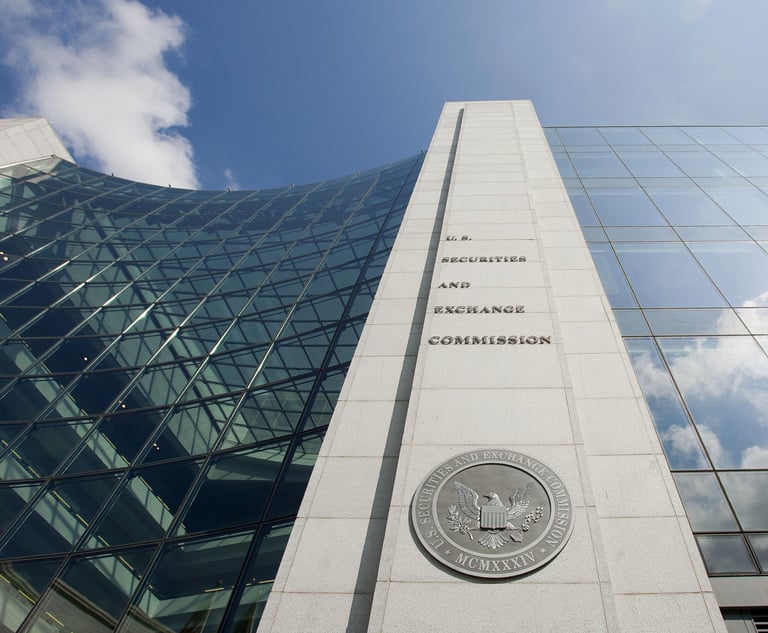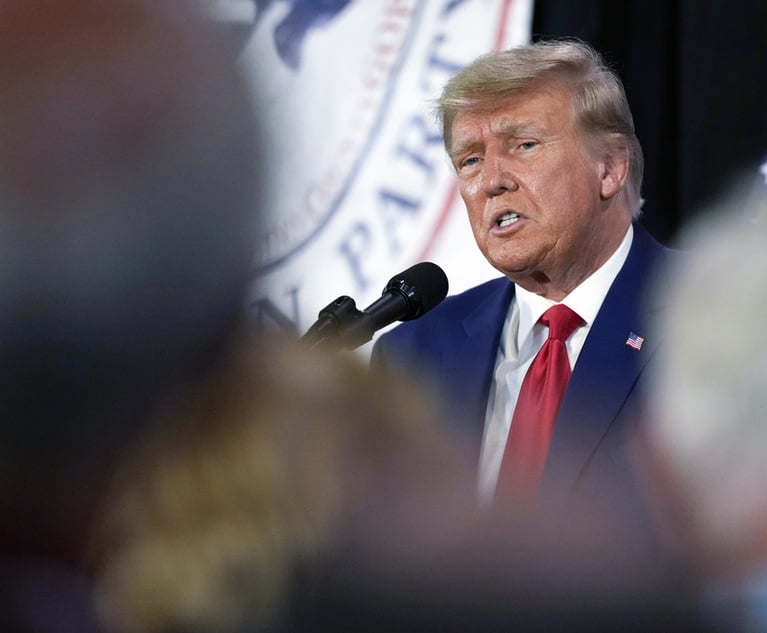Copycat Wars
Trademark owners develop aggressive legal and marketing strategies to fight counterfeiters.
February 28, 2006 at 07:00 PM
7 minute read
A college student strolls through the sidewalk kiosks of New York's Canal Street. She browses through handbags, jackets and shoes with designer logos: Louis Vuitton, Prada, Fendi. She finds a Gucci bag that matches her shoes and pays the merchant $40 for a designer bag that would cost 20 times as much at a store on Madison Ave.
Meanwhile, in the basement of a nearby building, a West African immigrant is locked in a tiny room. Day after day he glues fake designer labels to generic handbags, for sale in New York's Chinatown and in similar markets across the U.S.
Welcome to the 21st-century world of organized crime, where international networks of counterfeiters, traffickers and thugs are rooting their way into the global economy's foundations.
U.S. policy makers recognize the problem, but there's little U.S. regulation can do to stem the tide of illicit trade. The Stop Counterfeiting in Manufactured Goods Act, which both houses of Congress passed in 2005, will strengthen enforcement mechanisms in the U.S. Unfortunately, it will do little to deter counterfeiting operations outside U.S. borders.
“Counterfeiters don't risk real penalties, except the small chance of having their goods confiscated in the U.S.,” says Michelle Cooke, an attorney at Greenberg Glusker. “If governments don't take action within their own borders, there's no disincentive against trying to profit from someone else's marks.”
Some trademark owners, however, are creating those disincentives themselves by taking the fight to the counterfeiters on their home turf.
The 'Sopranos' State
Counterfeit goods are nothing new; in markets around the world, the fake Rolex has become so common it's a clich?? 1/2 . But today counterfeiting afflicts more than just markets for watches and overpriced purses. The counterfeit-goods trade is part of an international trafficking phenomenon–with implications far beyond the direct economic effect it has on luxury-goods retailers.
For example, at the six-party Korean summit last year, the North Korean contingent walked out in protest. This time the reason had nothing to do with the seating arrangements or nuclear research activities. This time the issue was, in part, counterfeit Viagra.
Specifically, the government was upset over U.S. financial sanctions against North Korean organizations accused of counterfeiting and trafficking in U.S. currency, cigarettes and drugs, and laundering the illicit gains.
The typical street-corner knock-off peddler might be far removed from such international intrigues, but counterfeiting and trafficking networks have spread across the planet, embedding themselves in manufacturing supply chains, transportation systems and government infrastructures.
“Counterfeiters are specialists in logistics,” says Mois?? 1/2 s Na?? 1/2 m, author of Illicit: How Smugglers, Traffickers and Copycats are Highjacking the Global Economy. “One day they can trade in DVS, the next in cigarettes, the third in weapons and the fourth in human beings.”
Owning The Problem
Facing such a sprawling and malignant problem, trademark owners and government agencies are having only limited success in their efforts to fight counterfeiting and piracy. The situation in China, the world's biggest source of counterfeit goods, illustrates the difficulties that complicate the war on counterfeiting. The central government's enforcement resources are stretched too thin, and government officials often are complicit in counterfeiting activities–in some cases because the officials are corrupt and in others because they are loath to shut down industries that boost local economies.
“China's laws on trademarks and copyrights are not bad laws,” says Ethan Horwitz, a partner with Goodwin Procter. “But the reality is there's no benefit to China in stopping it.”
The U.S. government can apply pressure on China via diplomatic and trade channels, but most of America's leverage is being applied to other causes deemed more important–such as nuclear proliferation and Taiwanese autonomy. Trademark owners must rely on their own devices to fight counterfeiting.
“Governments can't deliver on the promise to protect IP owners,” Na?? 1/2 m says. “Companies should be investing in technologies to protect their products rather than just lobbying for more government protection.”
Examples include packaging labels and tags that incorporate encrypted security information–using holograms and DNA coding–to distinguish real products from fake ones. Many companies are working to improve such techniques and apply them to their product lines.
“We have put anti-counterfeiting measures in our garment neck labels, and it has really helped us to identify counterfeits,” says Judy Henslee, trademark manager at Harley-Davidson Inc. These measures help dealers keep counterfeit products out of their stores, and allow customs agents to quickly distinguish fake from real goods.
Strength In Numbers
Despite technological advances, legal and investigative footwork always will be necessary to find counterfeiters and bring them to justice. Accordingly, many companies are becoming more aggressive in these efforts.
For example, after a two-and-a-half year investigation, Sharp Electronics successfully shut down a Singapore-based operation that counterfeited imaging paper for Sharp fax machines. Originally Sharp had brought lawsuits against distributors and dealers in the U.S. But to put the counterfeiters out of business, Sharp had to forego collecting damages from U.S.-based distributors to gain their cooperation in fingering the Singapore operation.
“You must have a broad strategy and be willing to take it as far as you need to go to shut down counterfeiters,” says Susan Kohlmann, the partner at Pillsbury Winthrop Shaw Pittman who worked on Sharp's case. “Companies should pick the cases that make sense for their markets and pursue them to the ultimate sources.”
Band Of Brothers
Additionally some trademark owners are banding together to cooperate on enforcement in various locations–including markets in the U.S. and the countries where fake goods are made.
“In China we joined forces with a number of other famous brand owners who are experiencing the same kinds of problems,” says Linda Heban, Harley-Davidson's chief trademark counsel. “We have more clout with the government when they see we've lined up with Prada, Chanel and Tiffany.”
Through such innovative approaches, trademark owners are becoming more resourceful in their war on the counterfeit-goods industry. Given the size and nature of the opponent, such a war might prove impossible to win. But by combining aggressive legal efforts with new technologies and strategic cooperation, trademark owners are defending their IP one battle at a time.
“Trying to get laws enforced is frustrating,” Heban says. “Enforcement resources are spread thin, and it takes time to turn evidence into an indictment. But we're no longer standing alone.”
——-
[Sidebar]
Fighting Counterfeiters
The U.S. House and Senate passed separate versions of the Stop Counterfeiting in Manufactured Goods Act in 2005. While details in the bipartisan legislation still must be finalized by House?? 1/2 Senate conferees, it has faced little opposition and seems likely to become U.S. law this year.
The legislation is intended to strengthen U.S. laws banning counterfeit trade in two primary ways. First, it requires law-enforcement agencies to seize assets used to manufacture or distribute counterfeit goods. Previously agencies could seize assets at their discretion, which sometimes allowed perpetrators to move their counterfeiting equipment and resume business almost immediately. Perhaps more importantly, it creates a regulatory standard that might influence other countries to seize counterfeiting assets as well.
Second, it closes a legal loophole that allowed counterfeiters to escape prosecution by shipping labels and tags separately from counterfeit items and assembling them at their destination. Taken together, these measures give trademark owners better weapons for fighting the battle against counterfeiting.
This content has been archived. It is available through our partners, LexisNexis® and Bloomberg Law.
To view this content, please continue to their sites.
Not a Lexis Subscriber?
Subscribe Now
Not a Bloomberg Law Subscriber?
Subscribe Now
NOT FOR REPRINT
© 2025 ALM Global, LLC, All Rights Reserved. Request academic re-use from www.copyright.com. All other uses, submit a request to [email protected]. For more information visit Asset & Logo Licensing.
You Might Like
View All
SEC Penalizes Wells Fargo, LPL Financial $900,000 Each for Inaccurate Trading Data

US Reviewer of Foreign Transactions Sees More Political, Policy Influence, Say Observers

Pre-Internet High Court Ruling Hobbling Efforts to Keep Tech Giants from Using Below-Cost Pricing to Bury Rivals
6 minute read
Preparing for 2025: Anticipated Policy Changes Affecting U.S. Businesses Under the Trump Administration
Trending Stories
- 1Freshfields Name Change Becomes Official
- 2Lawyers on TikTok Seek the Right Mix of Substance and Levity
- 3Chair of Montgomery McCracken Decamps for Morgan Lewis
- 4You Too Can Be a Programmer: Connecting to Legal Platform APIs With Generative AI (Part 2)
- 5Court of Appeals and Appellate Division As Courts of First Instance
Who Got The Work
Michael G. Bongiorno, Andrew Scott Dulberg and Elizabeth E. Driscoll from Wilmer Cutler Pickering Hale and Dorr have stepped in to represent Symbotic Inc., an A.I.-enabled technology platform that focuses on increasing supply chain efficiency, and other defendants in a pending shareholder derivative lawsuit. The case, filed Oct. 2 in Massachusetts District Court by the Brown Law Firm on behalf of Stephen Austen, accuses certain officers and directors of misleading investors in regard to Symbotic's potential for margin growth by failing to disclose that the company was not equipped to timely deploy its systems or manage expenses through project delays. The case, assigned to U.S. District Judge Nathaniel M. Gorton, is 1:24-cv-12522, Austen v. Cohen et al.
Who Got The Work
Edmund Polubinski and Marie Killmond of Davis Polk & Wardwell have entered appearances for data platform software development company MongoDB and other defendants in a pending shareholder derivative lawsuit. The action, filed Oct. 7 in New York Southern District Court by the Brown Law Firm, accuses the company's directors and/or officers of falsely expressing confidence in the company’s restructuring of its sales incentive plan and downplaying the severity of decreases in its upfront commitments. The case is 1:24-cv-07594, Roy v. Ittycheria et al.
Who Got The Work
Amy O. Bruchs and Kurt F. Ellison of Michael Best & Friedrich have entered appearances for Epic Systems Corp. in a pending employment discrimination lawsuit. The suit was filed Sept. 7 in Wisconsin Western District Court by Levine Eisberner LLC and Siri & Glimstad on behalf of a project manager who claims that he was wrongfully terminated after applying for a religious exemption to the defendant's COVID-19 vaccine mandate. The case, assigned to U.S. Magistrate Judge Anita Marie Boor, is 3:24-cv-00630, Secker, Nathan v. Epic Systems Corporation.
Who Got The Work
David X. Sullivan, Thomas J. Finn and Gregory A. Hall from McCarter & English have entered appearances for Sunrun Installation Services in a pending civil rights lawsuit. The complaint was filed Sept. 4 in Connecticut District Court by attorney Robert M. Berke on behalf of former employee George Edward Steins, who was arrested and charged with employing an unregistered home improvement salesperson. The complaint alleges that had Sunrun informed the Connecticut Department of Consumer Protection that the plaintiff's employment had ended in 2017 and that he no longer held Sunrun's home improvement contractor license, he would not have been hit with charges, which were dismissed in May 2024. The case, assigned to U.S. District Judge Jeffrey A. Meyer, is 3:24-cv-01423, Steins v. Sunrun, Inc. et al.
Who Got The Work
Greenberg Traurig shareholder Joshua L. Raskin has entered an appearance for boohoo.com UK Ltd. in a pending patent infringement lawsuit. The suit, filed Sept. 3 in Texas Eastern District Court by Rozier Hardt McDonough on behalf of Alto Dynamics, asserts five patents related to an online shopping platform. The case, assigned to U.S. District Judge Rodney Gilstrap, is 2:24-cv-00719, Alto Dynamics, LLC v. boohoo.com UK Limited.
Featured Firms
Law Offices of Gary Martin Hays & Associates, P.C.
(470) 294-1674
Law Offices of Mark E. Salomone
(857) 444-6468
Smith & Hassler
(713) 739-1250






